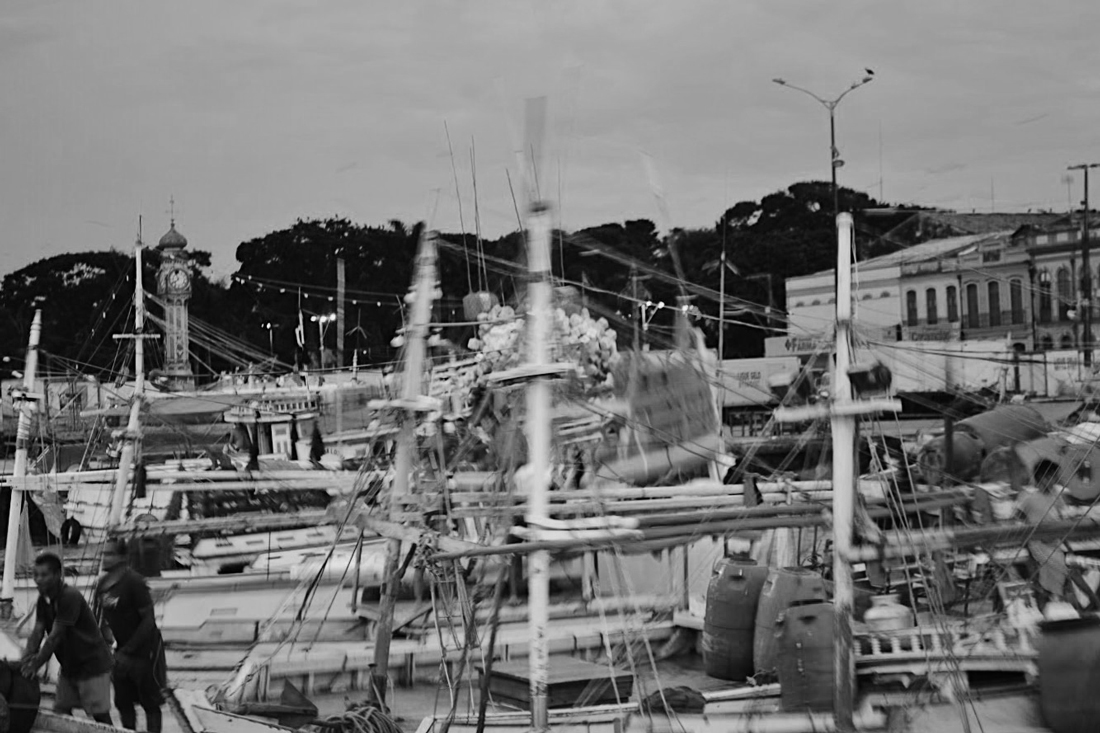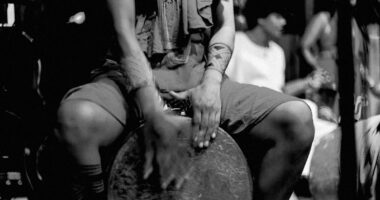
Pedra do peixe, ver-o-peso. Belém, 2018 | © Natalia Figueredo
Different communities, often marginalised by the dominant culture, have found in music a powerful form of expression and communication. Through music, they are able to preserve knowledge and experiences, keeping their roots and identity alive.
The other day, I heard the Carimbó master Damasceno say that there are things in the Amazonia that can only be known through music. At the table with him were some other important figures of the Amazonian culture of Pará (a region in northern Brazil), including Dona Onete, master Lourival Igarapé, Mam’eto Nangetu and Edson Catende.[1] Although their common ground was music, the conversation wandered onto memories, recipes, natural remedies and cultural heritage.[2]
This statement by Mestre Damasceno made me think of the work of the academic Antônio Maciel,[3] who has spent his career studying the Amazonian landscape as embodied in Carimbó, specifically the songs of master Lucindo, also known as the “poet of ecology.” Through his compositions, Lucindo, who was also a fisherman, not only portrays the daily life, trades and traditions of his environment, he also creates a poetic record of Amazonian life.
In the Pará region, the caboclos and ribeirinhos[4] live in harmony with the cycle of the waters, marked by the ebb and flow of the tides, something that is essential for the balance and renewal of species, both animal (including humans) and plant. In this environment, the caboclo move between different occupations: they work in the fields as shepherds, cultivate the land as farmers, and sometimes they fish, gathering sustenance from the river and the sea. They are also the architects of their own homes, which they build with the materials offered to them by the environment.[5]
The fisherman-poet Lucindo brings this world of the caboclo into his songs, with lyrics that depict the relationship with the land and the sea, as well as the work dynamics that shape life in the region of Marapanim, in the Atlantic Amazon:
The wave pulled that way
The wave pulled this way
I left my net in the sea
Just to see the little fish hold on.
Back on hard ground, he recounts lessons of agriculture learnt through practice:
I planted mangoes in the ground
Almond trees in the mangrove
The mango has already borne fruit
The almond tree does not want to give any.
By recording this knowledge of the environment and local know-how, music became a cornerstone of Amazonian caboclo culture. In this context, the acoustics and lyrics can be considered a form of oral literature that, through its verses, conveys the longings and experiences of certain segments of society, offering a unique portrait of their lives.
Music is an expression present in all human cultures throughout history, and it has the power of enhancing the memories entwined with it. In the case of Brazil – a country affected by colonial violence – oppressed populations established new languages and ways to adapt based on aspects of their cultures, one of which was undoubtedly music.
Theoreticians such as Paul Gilroy have been highlighting the importance of music in the African diaspora, where it becomes both a means of resistance and identity construction. In his book The Black Atlantic (2001), Gilroy argues that the exclusion of Black people from access to literature and literacy in the Western world was one of the main factors that strengthened sound and music as forms of expression and communication. In the Amazon, this process gave rise to cultural manifestations and celebrations that are woven into the local identity.
Since Carimbó is an Afro-Indigenous style, this is especially relevant where the differences in rhythm and lyrics are deeply connected to the environment and cultural memory in which the rhythm is embedded. In the state of Pará, the Carimbó has different traditional manifestations according to the geographical context. These include the pastoral Carimbó, typical of the island of Marajó; the rural Carimbó, from the Lower Amazon; and the beach Carimbó, characteristic of the Salgado region (Pará’s coastal area).
Knowledge of the tidal cycles, the Amazonian seasons and the biodiversity of each period of the year was ignored in the process of “modernisation” of the region, as it was considered empirical rather than scientific. Added to this was the fact that the region has historically been inhabited by indigenous peoples, caboclos, quilombolas and other traditional communities[6] that are commonly marginalised in Brazilian culture. This, together with an environment crossed by rivers and forests, fed into an image of the region as a backward place, reinforcing a perception of cultural and racial inferiority that still persists in the 21st century.[7]
Within this context, through their music, the mestres and mestras of Carimbó describe an Amazonian landscape that is perpetuated in language. Through oral transmission, they preserve knowledge and practices, making them repositories of wisdom within their communities. As guardians of this Afro-indigenous legacy, they ensure the continuity of a cultural heritage that keeps the roots and identity of their people alive.
Therefore, when master Damasceno states that there is an Amazonia that can only be experienced through music, he is not only referring to the process of transformation of the landscapes, driven by the march of deforestation and modernisation, but also to the fact that these communities, often subalternized, transmit and preserve their knowledge and experience through sound.
To paraphrase the words of Antônio Bispo dos Santos, also known as Nêgo Bispo, being in tune with our roots strengthens us and drives us forward. Like the waters of a river, which, when they flow into another course, do not cease to be themselves but become larger, also swelling the waters into which they flow.[8]
In this sense, music and cultural manifestations are the languages that connect the different parts of the Amazon. By becoming its rivers and tributaries, they reflect the multiple dimensions of this region while also generating a sense of belonging and collective identity.
[1] Maestro Damasceno, a Carimbó singer and composer from Salvaterra, on the island of Marajó, participated in the round table entitled “Popular wisdom and enchantment of care: music as an ancestral cure,” as part of the Motins cultural event, organised by the Psica music festival. Also present at the round table were Dona Onete, Carimbó singer and composer from Belém; Mam’eto Nangetu, mãe de santo (priestess) and founder of the Candomblé terreiro (chapel) Manso Massumbando in Belém; Edson Catende, singer, composer and babalorixá (priest) in the Belém Candomblé; and Lourival Igarapé, singer, composer and Carimbó master from Icoaraci, in Pará.
[2] The title of “mestre” (master) in Carimbó and other dances such as capoeira attributed – regardless of gender and age – to those who stands out from their specific group for their artistic skills, cultural knowledge and spirit of leadership.
[3] Antonio Maciel has a doctorate in Carimbó and has been researching Amazonian rhythms and oral traditions since 1981. What I know about his research comes from personal conversations I have had with Maciel, as well as from his article “Carimbó – um canto caboclo” (1983) [personal copy]. I have also drawn on the series of videos on his YouTube channel entitled Histórias e cantorias do pescador Lucindo – o mestre do carimbó, which were recorded on location in the city of Marapanim and in the Salgado region of northeastern Pará state (Brazil) with the poet, musician and master composer Lucindo in the late 1980s. These materials were used in his mater’s studies. More information can be found in the videos of the cultural map of Pará.
[4] Caboclo is a racial term for people of mixed indigenous and white descent. The ribeirinhos (or “river dwellers”) are communities that live along the banks of Amazonian rivers and which depend on the rivers for their subsistence through activities such as fishing, small-scale agriculture and river trade. Most of the riverine communities in the Pará region are made up of caboclos.
[5] V. Salles (1969), in Antonio Maciel (1983): «Carimbó, um canto caboclo», p. 127.
[6] Quilombolas are descendants of enslaved people in Brazil (Afro-Brazilians) who generally live in settlements called quilombos, initially established by people who fled the country’s plantations.
[7] For more information, see Loureiro, V. (2022). Amazônia: colônia do Brasil.
[8] This expression by Nego Bispo and other thoughts can be found in Priscila Carvalho: «Sankofa: Ideas ancestrais para a construção de futuros possíveis», Revista Amarello, 47, 2023.



Leave a comment